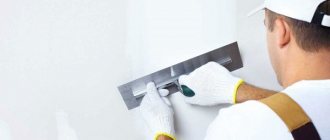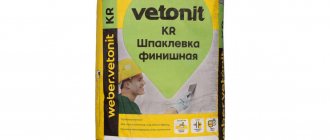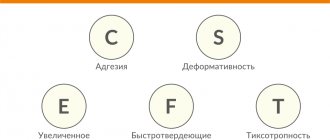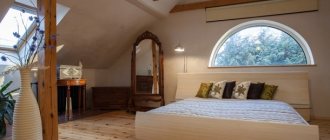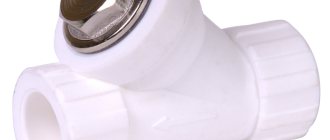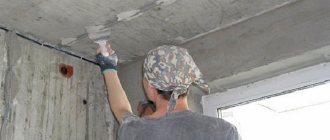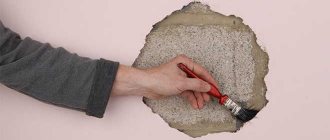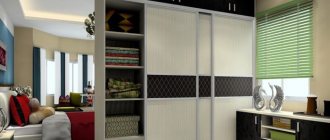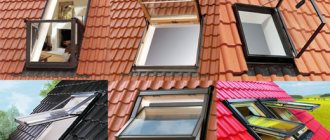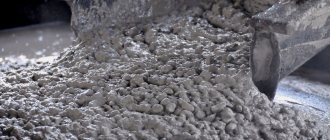- home
- Construction and renovation
- Walls
>
>
⬎
Many finishers and “not so many” are familiar with such a wonderful dry putty “fugen” (formerly it was called fugenfühler). It is usually used for sealing drywall joints, puttying holes and corners. For continuous puttying of walls, it is used much less often - it does not have the proper “ductility”, it is difficult to sand, does not have a white color and in general, it is harder for it to work. However, after understanding it a little, it becomes clear that the putty is very versatile, it can replace several types of other putties in repairs, it is much stronger than “its polymer counterparts,” and the consumption of this material is very pleasing. To putty a standard room in a panel, a 25-kilogram bag is enough.
Knauf putty: overview of varieties and their characteristics
Finishing work, including preparing surfaces and even giving their relief unusual shapes, cannot do without putty. The market is rich in choice, but many consumers are attracted to Knauf putty. The company offers a wide range of putty materials from powder mixtures to ready-made emulsions. Let's look at the most popular varieties. It is worth noting that all putty mixtures from this manufacturer contain adhesive ingredients.
How and with what to properly level the ceiling?
Wet leveling
To level the ceiling, you can use various methods and technologies. More recently, when plasterboard first appeared on the building materials market, the ceiling surface had to be leveled using various mixtures and solutions. This process was difficult and dirty. And although drywall has begun to slowly replace these methods, they are still used - especially in apartments and houses where the ceilings are low.
You understand that a plasterboard ceiling, whether you like it or not, eats up part of the height. Therefore, mixtures for leveling the ceiling are still used, and in some cases they are especially relevant.
Briefly about the product
Putty is a composition containing substances that form a film, filling irregularities, crevices and cracks. Used as a preparatory stage for interior and facade work. They come in the form of dry mixtures and ready-to-use without mixing the solution. This affects the price and shelf life. Ready ones can be frozen if the entire package is not used immediately.
The entire product line is divided according to two criteria:
Based on their composition, there are gypsum, cement and polymer mixtures, each of which has its own characteristics. Thus, the gypsum composition is the cheapest, but is not “friendly” with water - it is used only in those rooms where there is not and will not be a humid environment. Cement ones are several orders of magnitude stronger, but they shrink significantly. Polymer ones perform best, but they are also more expensive.
According to their intended purpose, the market offers: basic (starting), finishing (decorative) and universal. According to the name, the first is applied to plastered walls as a preparation, the second creates a perfectly flat, smooth surface, and the third, universal, can be used to seal large flaws on any surface.
Preparing the walls
The walls must be cleaned as much as possible of whitewash, paint, and crumbling parts. Often it is not possible to clean the walls of Soviet-era paint; in this case, what is removed is removed, and the wall, after being treated with a regular primer, is additionally treated with a concrete contact primer. Concrete contact has proven itself to be excellent, it exhibits good adhesion even to alkyd paints, the drawback is that it takes a long time to dry, subsequent work is recommended to be carried out no earlier than 12 hours after its application. These recommendations apply to concrete walls in panel houses; brick walls, as a rule, are not difficult to clean from paint and other things and you can get by with a regular primer. So, the walls are primed. Next, if plastering of the walls is not provided, you should tackle the corners.
Basic
The functions that this type performs are included in the name - processing, leveling surfaces at the initial stage to seal large holes. Apply in a thick layer of at least 2 cm. It should have good adhesion to the wall. Mandatory stage.
Knauf-Rotband Finish
Designed for plasterboard, tongue-and-groove and gypsum sheets. For interior work on top of gypsum and cement plasters. It is economically used and does not generate dust. After kneading, the working ability is maintained for 1.5 hours.
Source
Leveling compounds from Knauf
To the delight of a large number of consumers, the Knauf company, a leader in the production of drywall, is also a leader in the production of leveling mixtures. In this regard, the company tries to offer Knauf putties that are exactly suitable for plasterboard sheets from this manufacturer. Therefore, when you purchase gypsum board from this brand, immediately ask the sellers for putty mixtures. Their combined use is the highest guarantee of quality.
Knauf has a whole range of putties. Here are the main ones:
- Fugen GV. This gypsum and polymer based solution is used to seal seams and sheet surfaces. It has amazing properties: it does not crack or shrink, it is 100% environmentally friendly. It is produced as a dry mixture, which is brought to readiness by diluting with water.
- Knauf Rotband. This is also a gypsum mixture with polymer additives. Its main purpose is the finishing leveling of not only plasterboard sheets, but also concrete and plastered bases. It has increased strength and does not crack. Also dry.
- Uniflot. This dry gypsum putty is made from high-strength gypsum with the addition of polymer components. Used only for sealing seams. But please note that if Uniflot is used, then there is no need to use reinforcing paper tape or sickle tape. This type of Knauf putty is so durable.
Choosing putty - review of products from leading manufacturers
How to understand the abundance of ready-made and dry putty mixtures? After all, every manufacturer positions its product as the highest quality. In this article, we tried to systematize data on the most popular brands and help the reader in choosing putty specifically for their needs and according to their wallet.
The market for modern building materials is literally filled with various types of dry and ready-made building mixtures. And the Internet is simply overflowing with monotonous and often unreliable advertising information about the quality of these goods. Against this background, it can be quite difficult for a developer to figure it out and choose ordinary putty for himself. Let's try to take a closer look at the products of some of the best-selling manufacturers.
How to aim a fugen
The putty should be applied manually by adding the dry mixture to the water and then stirring it with a trowel. For the first layer, you don’t have to worry too much about laying it out, but subsequent layers need to be layered without lumps. This is done like this: water is poured into a container, and the dry mixture is slowly poured over the surface of the water with a trowel or directly by hand. You need to pour it slowly so that the dry mixture is completely saturated with water. Continue pouring until dry islands appear and there are practically no holes with water left. There is no need to stir while falling asleep!
Next, wait a few minutes, the dry islands will almost disappear, stir, the putty is ready. The density can be adjusted within small limits, without adding a little to the dry islands or pouring in so that there are more of them. Everything is achieved experimentally!
Knauf
The products of this concern, as a cheap panacea for all construction problems, flooded the markets of domestic construction stores. After sand and clay, dry plaster mixtures from this company seemed to many to be the pinnacle of quality.
In fact, there is not much truth in these words. Knauf offers high-quality products and the technologies they have developed for their use. And it’s not the manufacturer’s fault that its recommendations are read one line at a time and are translated rather unreliably.
As for putties specifically, the brand offers several types at once.
KNAUF-Fugen
Enrolled in putties. On what grounds, however, is not entirely clear. Classic adhesive repair mixture. It was originally developed for sealing joints between plasterboard sheets. Later, they began to use it for gluing gypsum boards on walls (since the hardening time of Fugen is longer than that of Perlfix). Puttying walls with this mixture is a pleasure, to put it mildly. And there is no need to do this. For putty, the manufacturer has better and more suitable recipes.
KNAUF-Fugen GW
Also an adhesive repair mixture, which has a fibrous structure, is only intended for sealing gypsum fiber board joints. Again, it is of little use for putty.
KNAUF-Fugen-hydro
The same “Fugen”, only for moisture-resistant drywall, with all the ensuing consequences. True, the thickness of the applied layer was increased by the manufacturer from 3 to 5 mm.
The ductility is slightly higher than that of the classic Fugenfüller, but still there are few people willing to putty with such a mixture.
KNAUF-Uniflot
And again glue. High-quality, high-strength, practically non-shrinking. Replaces any type of Fugen, and also surpasses it in technical indicators. But again, this is more of a repair mixture than putty in its pure form.
KNAUF-Rotband-Finish
Good putty. The manufacturer claims a reduced consumption of up to 20%, as well as a “lifetime” of the hammered mixture of up to one and a half hours. In fact, these figures are somewhat exaggerated, but there is still some sound evidence. In reality, you need to count on an hour of time, but this is more than enough to ensure that the solution does not go to waste.
KNAUF-Multi-Finish (gypsum)
Also a good putty for the money. The Knauf support service never told me what the fundamental difference between this mixture and Rotband-Finish is. In practice, Multifinish is easier to sand.
KNAUF-Multi-Finish M
Quite a good mixture for machine putty. However, no one will forbid putting putty with it even with an ordinary spatula. Moreover, the price for it is only slightly more than for a regular “Multi-Finish”.
KNAUF-HP Finish
Regular good quality finishing putty. One of the first that the then unspoiled Russian developer saw. Today, most more modern materials are superior to this mixture in quality, but habit is a great thing. Builders are a conservative people, they do not seek good from good, and therefore continue to use this mixture by inertia.
KNAUF Multi-finish paste
The answer from Knauf, to various “shitroks”. Plastic, soft and ready-to-use mixture. At first glance, it differs from the same “Shitrok” in its more reasonable price, but this is not entirely true.
KNAUF Rotband-Paste
For the inexperienced buyer, it is not much different from the similar Multi-Finish paste. Well, except that the price turned out to be 60 rubles. higher.
KNAUF Multi-finish (cement)
We haven’t forgotten about cement mixtures. Cement-based plaster mixture has the same name as gypsum. So you need to be careful when purchasing. Unlike gypsum compositions, the cement recipe, to put it mildly, did not catch on. Although in vain, quite decent putty for the money. The plasticity, of course, is not the same as that of gypsum, but there’s nothing you can do about it - cement is cement.
Does fugen crack?
I confess that in more than ten years of practice I do not remember such cases, even when the putty was stuffed into holes more than 5 centimeters deep, the most that could happen was that the putty gave a slight shrinkage. However, cracks may appear, for example, if the surface absorbs moisture very actively. For example, red brick takes up moisture like a sponge, so it must first be primed and the entire surface covered with the same fugen with a layer of less than 1 mm in order to clog the pores.
When covering deep holes up to 5 cm or more, to avoid cracks, the dry mixture must be applied with a minimum amount of water. For large layers, the consistency of soft plasticine will be just right. Naturally, the “lifetime” of the mixture is very short, so you need to have time to produce it.
If the putty cracks, it is most likely due to the mobility of the base itself. On various seams, joints and other places that raise doubts about the strength, you should glue the serpyanka mesh before puttingtying. Serpyanka can be from 5 cm wide or more, there are canvases more than a meter wide.
Henkel Bautechnik
An excellent manufacturer of dry and ready-made building mixtures. Ceresit, Thomsit and Ekon are all brands of this concern. True, when not conscientious Germans, but our compatriots, began to produce these same brands, simply using foreign technologies, the quality dropped somewhat, but still remained at a height unattainable for domestic companies.
The choice of putties at Henkel Bautechnik is not as extensive as that of Knauf, and is limited to some products of the Ceresit brand. But when choosing a product, stupid questions do not arise: how one mixture differs from another and why you need to choose one and not another. Everything is strictly to the point. There is a task - there is a mixture to complete it.
Ceresit CT 127
What I always liked about Ceresit was the order. No big names. A digital product code that cannot be confused with anything else. ST 127 is a polymer putty for work in dry rooms. The quality can compete with the same “Vetonit”. But it has a more attractive price. The ductility is average and can be rubbed tolerably well. But the quality of the finished wall is simply excellent.
Recommendations for using Knauf putty
- Try to follow the instructions on the package.
- Do not add a lot of water at once; it is better to add it little by little than to immediately ruin the mixture or throw away the frozen block.
- Wait until completely dry before proceeding with further work.
- Store powder mixtures tightly closed in a paper bag and only in a dry, warm place.
- Do not try to re-thread cured putty as this may affect the smoothness.
- Do not add foreign substances or agents to the solution.
- Apply a reasonable coat of putty to complete the drying process and prevent chipping.
- Consider the purpose of the room when choosing materials.
- Look at the expiration date on the packaging and ask the seller for a certificate of conformity.
- If the material behaves strangely, most likely the storage technology was violated or you came across a fake.
VIDEO: How to recognize a fake Knauf Rotband
Weber-Vetonit
The standard of quality among modern putties presented on the Russian market. The price for the products of this brand is not very pleasant, but the quality is beyond praise. A distinctive feature of all Vetonit putties is their increased ductility and enormous durability. And this makes the work very comfortable. The following putty mixtures are available to the buyer to choose from.
Weber.Vetonit VH
Cement-based putty, designed for exterior and interior use. It is especially loved by craftsmen for finishing walls and ceilings in bathrooms. Ideal for use on plaster layers made from Vetonit TT. And why not, if finances allow.
There are two types of putty: gray and white. Enterprising craftsmen immediately dubbed the gray one “Leveling” and the white one “Finishing”. (In a similar way, Knauf introduced “ceiling” plasterboard). Among the disadvantages of putty, one can highlight the high consumption of the mixture per millimeter of layer - about 1.2 kg per square meter.
Weber.Vetonit KR
Excellent putty based on organic glue. This means that the product is 100% natural. In fact, it’s not such an important fact, but if you have a thing for natural products, you can use it. Until it dries completely, it spreads a not very pleasant soapy “aroma”. After drying, the smell disappears.
Weber.Vetonit LR+
Putty on an inorganic, polymer base. The only difference in operation from Weber.Vetonit KR is the smell. Allows you to obtain a surface completely ready for painting.
You can find a lot of negative reviews on the Internet. They complain that if there is a need to re-glue the wallpaper, the latter are left behind with Vetonit putty. If you neglect construction technology and do not prime the putty surface, the result described above is quite possible. But the quality of the product has nothing to do with it.
Weber.Vetonit LR Fine
Very white and very delicate putty. Positioned as the finishing line. Although Weber.Vetonit LR+, which it is intended to cover, cannot be called a starter either. For those who love 4-6 layer putty cakes, this is just the thing.
Weber.Vetonit JS
Analogue of "Fugen" from "Vetonit". But you can work with it longer and it is softer to use. If desired, such a repair mixture can actually be used to putty, and even over paint.
Weber.Vetonit LR Pasta
Well, “Vetonit” could not stand aside and not release its analogue “Shitroka”. It turned out pretty high quality. Neither worse nor better, just not “Shitrok”, but “Vetonit”. Excellent for troubleshooting surfaces before painting. It can be used as the main putty, but is it rational?
Aligning corners
In general, this procedure does not apply to putty, but it is recommended to do this without plastering. If you want beautiful, right angles even if the walls are not level (not plumb) - forget about corner spatulas, a rule is needed here. The closer the height of the walls to the rule, the better. If the ceiling height is 2.5 meters, the rule is needed a little less so that it can be placed vertically in a corner and work with it freely. You can, of course, use a 1.5 meter one, but then you will have to spend more time and the result will be less impressive.
So, the corner consists of 2 adjacent walls; we will stretch each wall of one corner in turn. We apply a thick fugen to the wall along the entire height of the corner, so that there is at least a centimeter layer from the corner to the side of 30-40 cm. Next, we place the rule in the very corner and stretch it to the side along the applied putty. As a result, we get a vertical plane of putty mass, which must be eliminated as a rule after 30-40 cm from the corner. In order not to spread too much, while pulling the rule needs to be pressed into the wall, it will rest on the protruding sections of the wall and remove the excess, but in the places of the holes the mass will remain and become level with the protruding areas. Particular attention should be paid to the geometry of the resulting result; if various grooves have formed, there is no need to try to smooth them out with a spatula or trowel - after the mass has set, these defects will be eliminated with putty, the main thing is to make the angle in one line from floor to ceiling. Having trimmed half a corner in this way, move on to the next ones. It is recommended to go through the second wall of each corner using the same method after the first brushes have set. This is how we get unsightly corners due to the grooves, but their geometry is predetermined and it’s up to the putty.
In addition to the vertical corners, you can also trim the horizontal ones, where the ceiling or floor meet, so that the ceiling molding or plinth, when installed, does not show the curvature of the walls. However, then a reasonable question arises - if there is so much labor involved, wouldn’t it be more technologically advanced to plaster the walls along the lines so that all the corners are even and the walls themselves are also ideal? It's up to you to decide here, but I'll just say that pulling out the corners can be done with a fugen or a plaster gypsum mixture, for example a rotband from the same manufacturer. The advantage of rotband in this case is that it sets faster.
An important advantage of fugen is that it can be applied immediately after the rotband has set. There is no need to wait for complete drying.
Stabil
A Polish brand that has firmly established itself in the post-Soviet building materials market.
Produces dry and ready-made putty mixtures. The quality is good, but “Vetonita” does not reach the same level. Many craftsmen, accustomed to working with Stabil, simply do not recognize other putty mixtures. It’s disappointing that there is no Russian-language support on the manufacturer’s official website. But even Poles who are fluent in Polish will be able to glean little useful information from the resource.
Stabil PG 41
It was this product that made the company's name. This is understandable, the putty turned out to be of high quality. It mixes well, after production it does not lose its properties for about two hours (for “Vetonit” it takes a couple of days), and it is relatively easy to rub in. The resulting surface is ready for painting. Still, it seems that the price for this mixture is somewhat overpriced. In operation, it most closely resembles Ceresit CT 127, the cost of which is somewhat more modest, but this is only at first glance.
Stabil PSZ 11
Universal putty mixture. Similar to Rodband-Finish, Polish bottling.
Allows you to create a layer of up to 3 cm, while obtaining a surface ready for wallpapering.
Stabil PG-007
Ready mixture in buckets. Excellent quality, which, in fact, is not surprising for such products. Packaging 17 kg, with a consumption of 1.5 kg per millimeter layer per square meter.
The work is not much different from the same Vetonit or Knauf paste.
Putty for sealing drywall joints: which one to choose and which one is better
When creating plasterboard structures, leveling ceilings and walls using plasterboard, it is important to strictly follow the technology at all stages of work, from creating the frame to puttingtying the surface of the sheets. Particular attention should be paid to the joints of drywall, since improper processing of the seams will lead to the appearance of cracks in these places in the future, the joints will be noticeable through the finishing and the repair will be damaged. One of the important conditions for the correct processing of joints is the use not of ordinary finishing putty, but of a special putty for sealing drywall seams.
Types of putty mixtures
According to their purpose, putties are divided into several types:
- Starting – used for preliminary leveling. The main requirements for them are high adhesion to the base, strength and durability.
- Finishing – applied under the decorative coating. With their help, the smallest defects are eliminated, which allows you to get an ideal smooth surface.
- Universal - it is advisable to use by amateurs when they need to level the surface using one composition. There is no need to think about which putty to choose. Professionals prefer to use leveling compounds followed by finishing preparation.
Important! Conventional finishing and universal compounds are not suitable for sealing seams.
- Specialized - designed for specific purposes, for example, for sealing seams between sheets of drywall. It is recommended to use drywall and putty mixture, which are produced by one manufacturer.
Important! If for some reason you do not have the opportunity to use a special putty to seal the seams between the gypsum boards, you can use a high-quality starting compound.
Seam putties from well-known manufacturers
The difficulty in choosing putty is due to the wide variety and excess of advertising. It is advisable to systematize brands in order to select the desired composition in accordance with requirements and financial capabilities.
Specialized putties for sealing joints are produced in the form of dry mixtures. They are stored in bags for a long time and are prepared only before use.
"Knauf Fugen"
A relatively inexpensive putty that allows you to solve many problems when finishing premises.
The composition “Knauf Fugen” (the old name is “Fugenfüller”) is considered a putty, but can act as an adhesive repair mixture. It was developed specifically for sealing joints between sheets of drywall, but soon began to be used for gluing it to walls, repairing damage to drywall, installing corners, thin-layer puttying and other types of work.
It should be taken into account that Fugen putty is a quick-drying putty and it is advisable to prepare it in small portions.
Technical characteristics of Knauf Fugen putty:
- Composition: gypsum with additives to increase plasticity and slow down setting.
- It has a fine-grained structure with fractions up to 0.15 mm.
- The thickness of the applied layer is 1–3 mm. When sealing seams, putty is applied twice.
- Does not crack or shrink.
To prepare a composition for sealing joints and screw heads, take the dry mixture in an amount of 250 g and dilute it with water. This amount is enough for 1 sq. m of treated surface.
There are 3 varieties of this mixture:
- universal;
- “Fugen GV” - intended for sealing seams between gypsum fiber sheets;
- Fugen Hudro is a moisture-resistant variety, suitable for working with moisture-resistant drywall and additional protection of joints.
Apply the putty composition in 2 layers:
- Before applying the solution, the surface is primed.
- A reinforcing sickle mesh or paper tape is applied to the first layer and pressed in with a spatula.
- The second layer is applied to the dried surface.
Attention! The prepared solution should be used within 30–40 minutes.
"Knauf Uniflot"
Knauf Uniflot putty is a specialized super-strong waterproof mixture for plasterboard joints, its properties superior to all analogues.
- The increased strength brings it to the same level as the cement composition, however, the putty in question is significantly superior to it in ductility.
- Good adhesion, which brings this type of putty closer to synthetic glue, makes it possible to seal gypsum board joints with a semicircular thinned edge (PLUK) without the use of reinforcing tape.
- The composition does not shrink and does not crack.
- Perfect for sealing the most problematic transverse joints between gypsum boards.
- Suitable for rooms with any humidity. Despite the fact that the base of the mixture is gypsum, the putty does not absorb water after drying, acquiring hydrophobic properties.
The color of the powder can vary from snow-white to gray and even pink: this factor is associated with the location of gypsum extraction and does not affect the quality of the mixture.
Knauf Uniflot putty is designed to work no longer than 25–30 minutes. After this, the solution hardens. Hardened putty forms a durable coating, and it is difficult to sand it with sandpaper. The composition should be applied without calculating shrinkage, since the protrusions will then have to be ground down for a long time.
- the joints are filled, the composition is pressed in with a 150 mm wide spatula;
- after 50 minutes, excess material is removed, the surface is smoothed with fresh putty;
- the recesses from the screws are also processed in 2 passes.
When chamfering yourself at joints, you should use reinforcing paper tape, as for other compounds.
The high cost of the Knauf Uniflot putty mixture is compensated by the quality of the material. In addition, the sealed seam does not require much consumption.
"Volma Shov"
The dry solution contains gypsum as a base, enriched with mineral and chemical fillers. The putty has good adhesion. The working time of the diluted solution is 40 minutes.
- sealing gypsum board and gypsum board seams;
- eliminating cracks and potholes;
- eliminating micro-irregularities and obtaining a glossy surface.
- the joint is primed;
- then the first layer of putty is applied and the reinforcing tape is pressed in;
- after hardening, a second layer is applied;
- After hardening, it should be polished, for which a grater with a mesh is used.
The material is suitable for application to the entire plane of the sheet. Small graininess requires further application of a finishing layer.
"GENFIR PG 35 MW"
Dry gypsum mixture with additives. Before use, the base must be primed, otherwise the layer will settle. The solution retains its working properties for 2 hours. After hardening, cracks do not form. The putty is intended for dry rooms. The dry mixture is stored for 6 months.
Conclusion
When choosing putty for drywall joints, you need to focus on the conditions of use, your skills and expected costs. In some cases, a gypsum composition is suitable, in others it is waterproof. If you intend to solve a wide range of problems, it makes sense to choose Fugen from KNAUF; if you rely on quality and durability, it is better to purchase Uniflot.
Sheetrock
Famous American brand. The quality of ready-made Shitrok putties has become a proverb. Today, this product is manufactured not only overseas, but also in Russia. In particular, there are production facilities in St. Petersburg. Unfortunately, products manufactured in our country cannot be compared with their foreign counterparts. Although for anyone who has not used putty made in the USA, our Russian putty will seem simply the height of plasticity and perfection.
Today, many people try to perform putty work only with paste (the work is pleasant and comfortable), even to the point of applying 3-4 millimeters of it directly onto the plaster layer. This approach is extremely irrational.
Firstly, do not forget - “Shitrok” is a thin-layer putty mixture. And secondly, no one, of course, will forbid using it to tighten the entire wall or ceiling sheet, but it is still cheaper to use this product only for flaw detection of individual sections of the plane before painting.
Sheetrock SuperFinish
The main and most widespread product of the American manufacturer. A seventeen-liter container holds 28 kg of the finished mixture, so don’t be too scared by the declared 1.4 kg/m2 consumption. The mixture is multifunctional. It can be used to seal seams and pull a thin layer along the web. In general, a high-quality and super pleasant paste to use.
Sheetrock Fill & Finish Light
The same super finish, but 35% lighter and, as a result, 10 rubles less. more expensive per liter. Strange as it may sound, a lot of customers responded to this advertising move. True, it is unclear how an already thin millimeter layer can make the structure heavier, but if finances allow, then why not.
Sheetrock ProSpray
Ready putty for machine application. Fast, but expensive. The only but important advantage is that it is not afraid of freezing. Once frozen, it thaws and you can continue working. The main thing is not to warm it up artificially.
Sheetrock Dust Control
Another improvement from Shitrok. Lightweight putty with reduced dust formation during sanding. Once again it was a little more expensive than Sheetrock Fill&Finish Light. Some 30 rubles per liter.
Data for all the putty mixtures described above are shown in the table:
| Manufacturer | Products | Packaging, kg | price, rub. | Price 1 kg, rub. | Consumption per 1 m 2 1 mm layer, kg | Price 1 m 2 1 mm layer, rub. |
| KNAUF | KNAUF-Fugen | 25 | 388 | 15,52 | 0,8 | 12,42 |
| KNAUF-Fugen GW | 25 | 399 | 15,96 | 1,2 | 19,15 | |
| KNAUF-Fugen-hydro | 25 | 1066 | 42,64 | 0,8 | 34,11 | |
| KNAUF-Uniflot | 25 | 1197 | 47,88 | 0,5 | 23,94 | |
| KNAUF-Rotband-Finish | 25 | 360 | 14,40 | 1 | 14,40 | |
| KNAUF-Multi-Finish (gypsum) | 25 | 366 | 14,64 | 1 | 14,64 | |
| KNAUF-Multi-Finish M | 25 | 391 | 15,64 | 1 | 15,64 | |
| KNAUF-HP Finish | 25 | 241 | 9,64 | 0,9 | 8,68 | |
| KNAUF Multi-finish paste | 20 | 650 | 32,50 | 1,7 | 55,25 | |
| KNAUF Rotband-Paste | 20 | 710 | 35,50 | 1,7 | 60,35 | |
| KNAUF Multi-finish (cement) | 25 | 438 | 17,52 | 1 | 17,52 | |
| Ceresit | Ceresit CT 127 | 25 | 560 | 22,40 | 1,3 | 29,12 |
| Ceresit CT 225 | 25 | 594 | 23,76 | 1,2 | 28,51 | |
| Ceresit ST 95 | 17 | 890 | 52,35 | 1,7 | 89,00 | |
| Vetonit | Weber.Vetonit VH (gray) | 25 | 521 | 20,84 | 1,2 | 25,01 |
| Weber.Vetonit VH (white) | 25 | 862 | 34,48 | 1,2 | 41,38 | |
| Weber.Vetonit KR | 25 | 634 | 25,36 | 1,2 | 30,43 | |
| Weber.Vetonit LR+ | 25 | 692 | 27,68 | 1,2 | 33,22 | |
| Weber.Vetonit LR Fine | 25 | 728 | 29,12 | 1,2 | 34,94 | |
| Weber.Vetonit JS | 20 | 896 | 44,80 | 1,2 | 53,76 | |
| Weber.Vetonit LR Pasta | 20 | 700 | 35,00 | 1,7 | 59,50 | |
| Stabil | Stabil PG 41 | 25 | 638 | 25,52 | 1 | 25,52 |
| Stabil PSZ 11 | 20 | 364 | 18,20 | 1,2 | 21,84 | |
| Stabil PG-007 | 17 | 840 | 49,41 | 1,5 | 74,12 | |
| Sheetrock | Sheetrock SuperFinish | 28 | 1149 | 41,04 | 1,4 | 57,45 |
| Sheetrock Fill&Finish Light | 12 | 779 | 64,92 | 0,9 | 58,43 | |
| Sheetrock ProSpray | 28 | 1050 | 37,50 | 1,3 | 48,75 | |
| Sheetrock Dust Control | 3,6 | 349 | 96,94 | 0,9 | 87,25 |
Fugen shrinkage
Some authors claim that the putty not only does not shrink, but also expands in volume when drying. Fugen has a slight shrinkage; with continuous putty this effect does not manifest itself in any way; when puttying grooves and pits, the shrinkage is noticeable. Therefore, in order to putty the groove, you will have to go through a thin layer a second time. Regarding expansion, this is complete nonsense, most likely due to the “sinking” effect, when the layer is too thick or the mass is too liquid, it floats under its own weight and begins to bulge a little out of the plane. By the way, this phenomenon also occurs, as with most all kinds of putties: the putty groove sticks a little out of the plane, this happens due to the ductility of the mixture. This problem is solved by applying in one direction and removing in the other. You need to remove it by holding the spatula perpendicular to the wall. In addition, you need to wait until the putty begins to rise and go along the groove with a spatula, holding it in the same way, at a right angle to the wall. Experienced finishers are familiar with this phenomenon; it also occurs when constructing screeds with special mixtures.
The grooves must be covered with fugen in two passes. In the first pass we apply the main layer, in the second pass we even out possible shrinkage.
Choosing putty. Review of products from leading manufacturers
How to understand the abundance of ready-made and dry putty mixtures? After all, every manufacturer positions its product as the highest quality. In this article, we tried to systematize data on the most popular brands and help the reader in choosing putty specifically for their needs and according to their wallet.
The market for modern building materials is literally filled with various types of dry and ready-made building mixtures. And the Internet is simply overflowing with monotonous and often unreliable advertising information about the quality of these goods. Against this background, it can be quite difficult for a developer to figure it out and choose ordinary putty for himself. Let's try to take a closer look at the products of some of the best-selling manufacturers.
Comparison of putties from Sheetrock, Knauf, Vetonit - how to choose the best putty?
Manufacturers of leveling mixtures have simply bombarded the modern market with their products. Here are Sheetrock and Knauf putties, and Vetonit and Yunis compositions. There are quite a few of them, and each has its own advantages, and understanding them is not always easy.
The variety is so huge that the question constantly hovers among consumers, which putty for drywall is better? To understand this, it is necessary to consider the proposed types.
Putty from Sheetrock
Shitrok putty is a leveling material based on high quality polymers. And if we talk about surface finishing, this material has no equal. The composition can be based on vinyl fibers, marble chips, and other fillers. That is, it can be both a leveling material and decorative plaster.
We are interested in the first sample, because we are considering the topic of how best to putty drywall. So, why is Shitrock so popular?
- Firstly, it is an opportunity to purchase ready-made putty. It is sold in plastic containers. Or buy semi-finished material - this is a dry mixture that will have to be diluted with water in certain proportions. The first one is more expensive than the second one, and it also has a shorter shelf life.
- Secondly, the solution is polymer-based, which means that Sheetrock putty applied to the surface will never crack. At least for the warranty period.
- Density – 1.65 kg/l.
- Drying time – 5 hours.
- Consumption – 150 g/m².
- The shelf life of the finished putty is 1 year.
- The color of the material is white.
- It is usually packaged in plastic buckets of 5-28 kg.
- The recommended thickness of the applied layer is 3 mm.
Leveling compounds from Knauf
To the delight of a large number of consumers, the Knauf company, a leader in the production of drywall, is also a leader in the production of leveling mixtures. In this regard, the company tries to offer Knauf putties that are exactly suitable for plasterboard sheets from this manufacturer. Therefore, when you purchase gypsum board from this brand, immediately ask the sellers for putty mixtures. Their combined use is the highest guarantee of quality.
Knauf
The products of this concern, as a cheap panacea for all construction problems, flooded the markets of domestic construction stores. After sand and clay, dry plaster mixtures from this company seemed to many to be the pinnacle of quality.
In fact, there is not much truth in these words. Knauf offers high-quality products and the technologies they have developed for their use. And it’s not the manufacturer’s fault that its recommendations are read one line at a time and are translated rather unreliably.
As for putties specifically, the brand offers several types at once.
KNAUF-Fugen
Enrolled in putties. On what grounds, however, is not entirely clear. Classic adhesive repair mixture. It was originally developed for sealing joints between plasterboard sheets. Later, they began to use it for gluing gypsum boards on walls (since the hardening time of Fugen is longer than that of Perlfix). Puttying walls with this mixture is a pleasure, to put it mildly. And there is no need to do this. For putty, the manufacturer has better and more suitable recipes.
KNAUF-Fugen GW
Also an adhesive repair mixture, which has a fibrous structure, is only intended for sealing gypsum fiber board joints. Again, it is of little use for putty.
KNAUF-Fugen-hydro
The same “Fugen”, only for moisture-resistant drywall, with all the ensuing consequences. True, the thickness of the applied layer was increased by the manufacturer from 3 to 5 mm.
The ductility is slightly higher than that of the classic Fugenfüller, but still there are few people willing to putty with such a mixture.
KNAUF-Uniflot
And again glue. High-quality, high-strength, practically non-shrinking. Replaces any type of Fugen, and also surpasses it in technical indicators. But again, this is more of a repair mixture than putty in its pure form.
KNAUF-Rotband-Finish
Good putty. The manufacturer claims a reduced consumption of up to 20%, as well as a “lifetime” of the hammered mixture of up to one and a half hours. In fact, these figures are somewhat exaggerated, but there is still some sound evidence. In reality, you need to count on an hour of time, but this is more than enough to ensure that the solution does not go to waste.
KNAUF-Multi-Finish (gypsum)
Also a good putty for the money. The Knauf support service never told me what the fundamental difference between this mixture and Rotband-Finish is. In practice, Multifinish is easier to sand.
KNAUF-Multi-Finish M
Quite a good mixture for machine putty. However, no one will forbid putting putty with it even with an ordinary spatula. Moreover, the price for it is only slightly more than for a regular “Multi-Finish”.
KNAUF-HP Finish
Regular good quality finishing putty. One of the first that the then unspoiled Russian developer saw. Today, most more modern materials are superior to this mixture in quality, but habit is a great thing. Builders are a conservative people, they do not seek good from good, and therefore continue to use this mixture by inertia.
KNAUF Multi-finish paste
The answer from Knauf, to various “shitroks”. Plastic, soft and ready-to-use mixture. At first glance, it differs from the same “Shitrok” in its more reasonable price, but this is not entirely true.
KNAUF Rotband-Paste
For the inexperienced buyer, it is not much different from the similar Multi-Finish paste. Well, except that the price turned out to be 60 rubles. higher.
KNAUF Multi-finish (cement)
We haven’t forgotten about cement mixtures. Cement-based plaster mixture has the same name as gypsum. So you need to be careful when purchasing. Unlike gypsum compositions, the cement recipe, to put it mildly, did not catch on. Although in vain, quite decent putty for the money. The plasticity, of course, is not the same as that of gypsum, but there’s nothing you can do about it - cement is cement.
Sanding walls
It is recommended to sand the walls after applying the last layer, and in the intermediate stages it is best to cut off various bumps and defects with a spatula. If you sand between layers, the sanding dust will cause the putty to quickly set on the putty knife and cause grooves to appear on the surface. To eliminate this unpleasant phenomenon, you will have to prime the walls again every time after sanding. And on a primed wall, the newly laid layer will take longer to set. In general, this procedure is not prohibited, it simply increases the total time of work.
Many people claim that this putty is very difficult to sand. There is a lot of truth in this, but it’s worth noting that a surface that has been puttied to “scrape off” practically does not require cleaning, just knocking down rare bumps. All sorts of fancy meshes are not entirely suitable for sanding - regular sandpaper is more effective.
During grinding, the advantage of this wonderful material is revealed: there is much less dust, provided that the puttying was done as a “stripping”.
Henkel Bautechnik
An excellent manufacturer of dry and ready-made building mixtures. Ceresit, Thomsit and Ekon are all brands of this concern. True, when not conscientious Germans, but our compatriots, began to produce these same brands, simply using foreign technologies, the quality dropped somewhat, but still remained at a height unattainable for domestic companies.
The choice of putties at Henkel Bautechnik is not as extensive as that of Knauf, and is limited to some products of the Ceresit brand. But when choosing a product, stupid questions do not arise: how one mixture differs from another and why you need to choose one and not another. Everything is strictly to the point. There is a task - there is a mixture to complete it.
Ceresit CT 127
What I always liked about Ceresit was the order. No big names. A digital product code that cannot be confused with anything else. ST 127 is a polymer putty for work in dry rooms. The quality can compete with the same “Vetonit”. But it has a more attractive price. The ductility is average and can be rubbed tolerably well. But the quality of the finished wall is simply excellent.
Ceresit CT 225
The putty for facades is made on the basis of cement. In general, it seems to me that Ceresite works especially well with mixtures with cement. The advantages of the mixture include reinforcing additives. The disadvantages are that so that these additives do not settle and are distributed evenly, the mixture must be constantly stirred.
Ceresit ST 95
Similar to “Shitrok” for outdoor work. It is, to put it mildly, expensive, and therefore it is used quite rarely for its intended purpose. It has proven itself well among builders as a repair-defect mixture. Somewhere to correct, somewhere to cover up a crack. Using ST 95 in large volumes is too expensive.
Distinctive characteristics of the work
Consideration of the question of how to plaster foam for installation work must begin with the process of selecting materials and preparing tools . Using the right devices makes the job much easier and makes it possible to achieve excellent results, even without repair expertise.
Selection of composition and tools
So, how to plaster the foam for installation work so that the coating is durable and reliable?
Here it is necessary to take into account the following points:
- Where the cladding will be carried out, when working in the middle of the premises, quite a few compositions are suitable, while for external putty the solution must have water-repellent qualities, be able to withstand temperature changes well and not be damaged by the sun.
- Layer thickness and slot width. As everyone knows, putty must be applied in a thin layer, while plaster can be used to smooth out even significant differences. This nuance is very easy to establish by looking at all the places that require finishing; we remind you that it is often better to use a plaster solution.
Stabil
A Polish brand that has firmly established itself in the post-Soviet building materials market.
Produces dry and ready-made putty mixtures. The quality is good, but “Vetonita” does not reach the same level. Many craftsmen, accustomed to working with Stabil, simply do not recognize other putty mixtures. It’s disappointing that there is no Russian-language support on the manufacturer’s official website. But even Poles who are fluent in Polish will be able to glean little useful information from the resource.
Stabil PG 41
It was this product that made the company's name. This is understandable, the putty turned out to be of high quality. It mixes well, after production it does not lose its properties for about two hours (for “Vetonit” it takes a couple of days), and it is relatively easy to rub in. The resulting surface is ready for painting. Still, it seems that the price for this mixture is somewhat overpriced. In operation, it most closely resembles Ceresit CT 127, the cost of which is somewhat more modest, but this is only at first glance.
Stabil PSZ 11
Universal putty mixture. Similar to Rodband-Finish, Polish bottling.
Allows you to create a layer of up to 3 cm, while obtaining a surface ready for wallpapering.
Stabil PG-007
Ready mixture in buckets. Excellent quality, which, in fact, is not surprising for such products. Packaging 17 kg, with a consumption of 1.5 kg per millimeter layer per square meter.
The work is not much different from the same Vetonit or Knauf paste.
Puttying with fugen
The whole process differs from the usual in that the applied putty is removed with a spatula located perpendicular to the surface to be putty. Layers should be alternated in directions: if the previous layer was applied from bottom to top, then the next layer should be applied as desired, but try to remove the mass from left to right or from right to left. This method is also called “tear up” putty. Some authors argue that this method is only appropriate when the walls are initially very smooth, but I will answer this way: very curved walls can also be puttied this way, just 2 layers are not enough. In this way you will have to putty at least 4 times.
Most of the material goes into the first layer; in fact, the purpose of the following layers is to tidy up the first one. You can also putty with fugen in the usual way - by smoothing the mass at a slight angle, the essence is simple - the closer the surface of the entire spatula is to the wall, the smoother the result will be. But the more attractive the wall looks after one coat, the more ripples and unevenness you will add to the wall. You should putty with fugen so that when removing the applied mass, the spatula is approximately 90 degrees to the wall. The first layer will give the impression of being “not very good”, but after the second and subsequent layers you will understand that you are on the right track. An excellent result on curved walls can be achieved by plastering the first 1-2 layers with a short meter rule, using it as a spatula.
When one or more layers have already been applied to the wall, an unpleasant phenomenon occurs: when removing the applied mass, particles from the previous layer get into the putty, the old particles leave grooves, because of this, the putty begins to harden faster on the putty and you have to throw out small portions from the putty when puttingty it gets hard. To minimize this phenomenon, before application you should cut off the “snot” remaining from the previous layer with a spatula. And you should try to putty immediately after the previous layer has hardened - the surface is still wet and absorbs moisture less actively, this will significantly increase the life of the putty on the spatula.
Introductory information
Just a few years ago, the Knauf company sold a dry construction mixture called Fugenfüller. It is under this name that high-quality construction putty is remembered by Russian buyers. Now the product has a new name - Knauf Fugen, and is used primarily for large-scale construction work inside residential and industrial premises.
Due to its unique composition, the material has a long service life and is not susceptible to environmental factors. The main component of the putty is gypsum, as well as additional binding chemical elements (provide increased plasticity).
This is a truly universal building material; it can be used to repair microcracks in the wall and ceiling. If desired, you can eliminate unevenness or oversights in the painting of various load-bearing structures. Not a single major renovation is complete without finishing, and the interior design of a country house is simply impossible to imagine without the use of Knauf Fugen putty.
Important! The manufacturing company has changed the name of its product to Fugen (this is an analogue), so if you come across a product in the store with the name “Fugenfühler”, you should know that it is an expired copy (always check the expiration date before purchasing building materials).
Features of the work
Sheetrock gypsum is applied to a stable, hard, clean and dry substrate. Remove all substances that negatively affect adhesion. These are resin, chalk, dust, paint coatings, etc. Hygroscopic bases are pre-primed.
Perfect surface with Sheetrock
Apply the putty mixture mechanically or manually. Each subsequent layer is applied after the previous layer has completely hardened. This requires at least 3 hours, preferably 5. After final hardening, the surface is sanded. To do this, you will need abrasive paper, the size of which does not exceed 240 units.
Advantages and disadvantages
Like any building material, putty has advantages and disadvantages. The advantages of this product include:
- the ability to carry out construction work with such a fastidious material such as drywall;
- obtaining the most durable seam, which ensures the durability of the construction and installation work;
- low consumption of putty solution and affordable price;
- environmental friendliness and safety for the health of people and pets;
- the material is sold in 25 kg bags - this amount is enough to finish a large area.
Experts include the following disadvantages of this product:
- extremely fast drying process, which limits the use of the material in domestic conditions;
- impossibility of use with sharp bends of the structure (more than three millimeters);
- a long and difficult process of grinding the surface layer.
On the video: the purpose and characteristics of Fugenfüller putty.
Vetonit mixtures
Vetonit putty is quite well known - it is a finishing solution after which you can apply paint or glue wallpaper. In addition to gypsum, the composition also includes polymer glue. It is this that sets the tone for high performance, especially with regard to the strength of the applied layer. By the way, its thickness is 1-5 mm. Material consumption is 1.2 kg/m² with an applied layer thickness of 1 mm.
Please note that Vetonit putty can only be used in dry rooms and only for interior work. Packaged in 25 kg paper bags, shelf life 18 months. The prepared solution can be used within 24 hours, after which it sets and cannot be used.
Eunice Slade putty is used only for sealing seams. Some inexperienced craftsmen use it to level the surfaces of gypsum board sheets. And this is a big mistake. Even a primed surface cannot guarantee good adhesion of this solution to the smooth surface of plasterboard sheets. Someone might recommend this option - apply notches with a knife or other sharp instrument, and after that use this type of putty. In principle, this is possible, but is it worth it? After all, there are mixtures on the market that are designed specifically for these purposes. There are universal options. Therefore, you should not experiment.
Where are the products used?
The areas of use of Fugen putty include:
- elimination of seams and microcracks between concrete structures;
- sealing cuts and chips in plasterboard sheets;
- partial or complete puttying of walls made of concrete, plasterboard and other materials;
- transformation (grouting) of uneven plasterboard structures, as well as hiding cracks on the surface of tongue-and-groove slabs;
- connecting role in installation work (for example, installation of reinforcing corners);
- Putty is used as an adhesive solution to connect several parts of plasterboard structures.
Advantages of using Sheetrock ready-mix
The finished solution is sold at a price higher than dry masses, but Sheetrock has a much larger list of advantages:
- Maximum time savings;
- The ethylene vinyl acetate polymer included in the putty ensures reliability and long service life of the base;
- The material perfectly covers the surface with a two-layer coating, the thickness of each layer is 0.1 - 0.2 cm. The average consumption when applying a layer of 0.1 cm is only 67 kg per 100 m2;
- Versatility. The composition is suitable for application to any surface;
- Sheetrock gypsum base provides reliable adhesion to concrete bases, even those made of cellular material. Also putty when performing work on old foundations - strengthening, restoration. The composition is recommended for use when working with gypsum fiber and gypsum board;
- Applied to the surface manually and mechanically;
- Gypsum putty allows for texturing.
Sheetrock fits perfectly on the surface, as the following video clearly demonstrates.
